The following key utilizes features of adult structure. The differences in external structure between some of the species are rather subtle (e.g. between B. balli and B. foveum). For these, an examination of the male genitalia is sometimes necessary for accurate identification. A page comparing male genitalia may be of use while examining genitalia.
1. Distinct smooth patches ("mirrors") on elytra, at least on interval 3 surrounding silver spots, or elytra generally smooth and shiny ............................................3Click on an image to view larger version & data in a new window1'. Distinct elytral mirrors lacking, interval 3 between silver spots dull, or at least not markedly shinier than rest of elytra ......................................................2
Click on an image to view larger version & data in a new window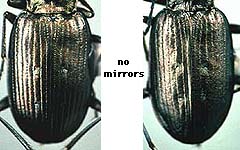
2(1). Pronotum small in comparison to the long elytra (ratio of elytral length to pronotal width 2.44-2.60). Male protarsomere 1 relatively large (the tarsus shown below is at the same scale as that shown in the other half of this couplet for B. balli; note the relative sizes of the the first and third protarsomere). ..........B. foveum Motschulsky 2'. Pronotum and elytra of typical proportions (ratio of elytral length to pronotal width 2.25-2.35). Male protarsomere 1 of normal size .................................B. balli Lindroth
3(1). Intervals 6 or 7 with mirrors as or nearly as distinct as interval 3 mirrors, at or near level of silver spots .......133'. Outer elytral intervals lacking distinct mirrors, more or less uniform in luster ......................................4
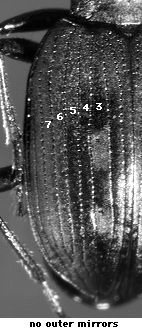
4(3). Midlateral seta of pronotum present (if the seta has broken off accidently, then its former presence is indicated by a pore puncture in the lateral margin) ........................54'. Midlateral seta of pronotum absent ..........................8
5(4). Large (standardized body length generally more than 6.2 mm) and shiny, with wide body. Prothorax wide at base, with sides little sinuate. Mentum tooth large, bulbous, rectangular, without distinct epilobes .......................................B. punctatostriatum Say5'. Smaller (standardized body length generally less than 6.2 mm) and in most specimens duller. Body proportions more normal, not atypically wide. Prothorax more constricted near base. Mentum tooth smaller, flatter, triangular or trapezoidal, epilobes distinct ..............................6
6(5). Pronotum with distinct, long carina inside hind angles near base; carina extended to basal edge of pronotum ..........................................B. carinula Chaudoir 6'. Basilateral carina, if present, thin, oblique, and short, not extended to basal edge of pronotum ......................7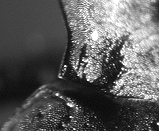
7(6). Third elytral interval wide, 1.7-2.6 times as wide as second (most noticeable around anterior silver spot). Pronotum flatter, with flaring hind angles. (Holarctic.) .....................................B. lapponicum Zetterstedt 7'. Third elytral interval narrower, 1.4-1.6 times as wide as second. (As you can see from the figures, this difference is not striking in some specimens.) Pronotum more convex, hind angles less prominent. (Palearctic.) .......................................B. velox (Linné)
8(4). Small (standardized body length = 4.4-5.4 mm) specimen, elytra narrowing apically, striae deeply impressed; legs mostly pale, rufous. Generally with two setae in neighborhood of ed7. (Japan and neighboring mainland.) ...........................................B. stenoderum Bates8'. Generally larger, with wider elytra and less fusiform shape. Generally with one seta at ed7 ..............................9
9(8). Shoulder margin longer, reaching or nearly reaching stria 5. Female second stylomeres exceptionally long. (Palearctic region and Alaska.) ........................................10 9'. Shoulder margin shorter, reaching at most just beyond stria 6. Female second stylomeres of normal length. (Western North America south of Alaska.) ..................................12
10(9). Legs pale rufous. Dorsal surface of body shiny, with inconspicuous mirrors and silver spots. Interval 3 narrow ..........................................B. semenovi Lindroth 10'. Legs darker, at least apex of femur as well as tibia and tarsus infuscated. Duller, with mirrors and silver spots in most specimens more distinct. Interval 3 wider .............11
11(10). Duller, elytra in most specimens distinctly duller than pronotum. ed3 and ed5 near center of silver spots. Extra setae between eo4 and eo5 generally absent. Protarsomere 4 ventroapical setae widely separated .....B. alaskense Lindroth11'. Dorsal surface, including elytra, shinier. ed3 and ed5 at or near anterior edge of silver spots. Extra setae between eo4 and eo5 generally present. Protarsomere 4 ventroapical setae narrowly separated ......................B. argenteolum Ahrens

12(9). Small (standardized body length = 4.7-5.8 mm). Very shiny and dark. Microsculpture in shinier areas of elytral disc consisting of transversely stretched sculpticells, at least in males. Femora generally with basal half rufous ............................................B. hesperium Casey12'. Larger (standardized body length = 5.3-6.8 mm). Duller and brighter. Elytral microsculpture isodiametric throughout. Femora entirely piceous or black ........B. lorquinii Chaudoir

13(3). Mentum tooth rectangular, bulbous, epilobes indistinct. (Nearctic.) ................................................1413'. Mentum tooth flatter, not bulbous, epilobes distinct .......15
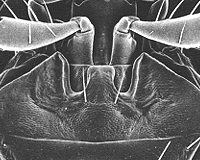
14(13). Mirrors on intervals 6 and 7 more or less isolated from mirrors on inner intervals, and present near level of posterior silver spot ........................B. inaequale Say 14'. Outer elytral mirrors broadly connected to inner mirrors; outer mirrors closer to anterior silver spots .............................................B. levettei Casey
15(13). Lateral margins of pronotum wide, flared into protrudent front angles. (Pacific coastal beaches of North America.) ..............................................B. zephyrum FallClick on an image to view larger version & data in a new window15'. Pronotal margins narrower. (Palearctic.) ...................16
16(15). Pronotum flatter with sides at most slightly sinuate; midlateral seta absent; ed3 and ed5 generally at anterior edge of silver spots .................B. conicolle MotschulskyClick on an image to view larger version & data in a new window16'. Pronotum more convex, sides more rounded; midlateral seta present or absent; ed3 and ed5 generally closer to center of silver spots ............................B. litorale (Olivier)
Click on an image to view larger version & data in a new window









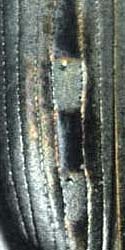
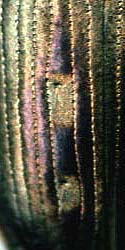

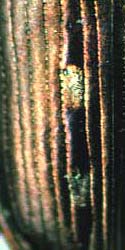
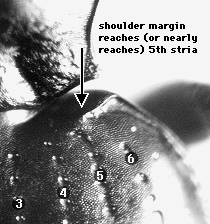
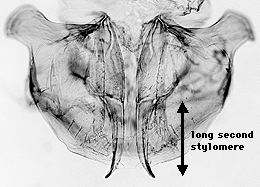
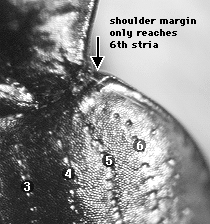
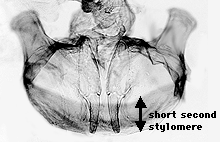



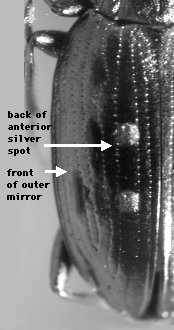


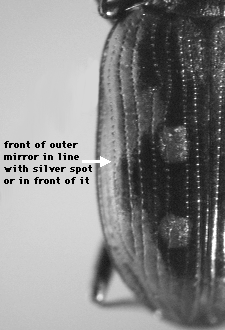




 Go to quick links
Go to quick search
Go to navigation for this section of the ToL site
Go to detailed links for the ToL site
Go to quick links
Go to quick search
Go to navigation for this section of the ToL site
Go to detailed links for the ToL site